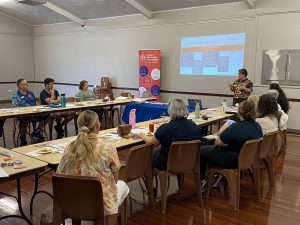Step 5. Facilitate sustainability of changes
Embed sustainability into the action plan
Considering how successful interventions can be continued and resourced ongoing will be important. Sustainability considerations should be built into an action plan during the co-design planning process.
As much as possible, ensure that actions are associated with a partner (individual or organisation) who will be responsible for progressing the action. This is challenging and often requires further engagement. Clear, timely and ongoing communication with key stakeholders who have been identified as having influence in progressing actions will aid in this endeavour.
Action plans might also identify a range of actions that have longer timeframes and action owners who might sit outside the community, such as jurisdictional/federal level government departments. Strategies should be built into the action plan to identify “hand over” strategies to relevant bodies to facilitate their inclusion in other action registers and existing bodies of work.
Consideration can be given to the role of existing consortia/organisations such as academic health centres, university departments of rural health, or government committees in taking forward key learnings and longer term priorities identified by the community.
Mechanisms for inclusion of the action plan in existing health planning cycles or other relevant planning cycles for the community should be identified and accessed.
Action plans should be revised regularly to determine current and new priorities (which may change over time).
Encourage and support advocacy for change and in pursuit of resources and funds in the future.
Ensure that the action plan, reports generated through the co-design process and background reports are entrusted to key community groups and health services for future use. Strong stakeholder buy-in to the need for the action plan is essential for the plan and identified actions to be progressed past the planning project timeline.

In one project community, an aim was to ‘strengthen connections between all health and health-related service providers and organisations that serve the Clermont community’, with an action being to facilitate service provider forums (figure 4.5.1). An existing agency took on the coordination of these meetings, and by embedding the responsibility for the action, meetings of providers continue every two months beyond the project.


Collaborating with existing local groups and integrating actions into partners’ scopes where possible will help ensure long-term sustainability.

